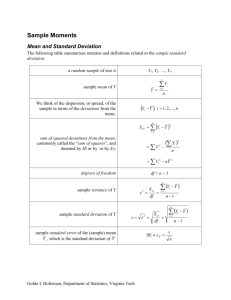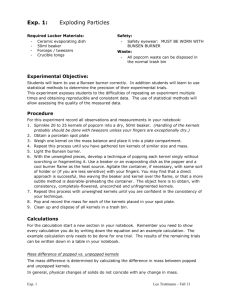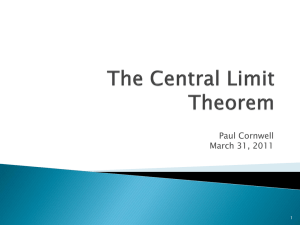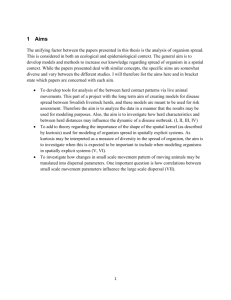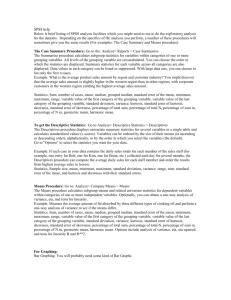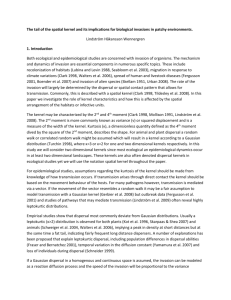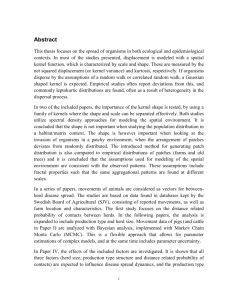l - IFM
advertisement
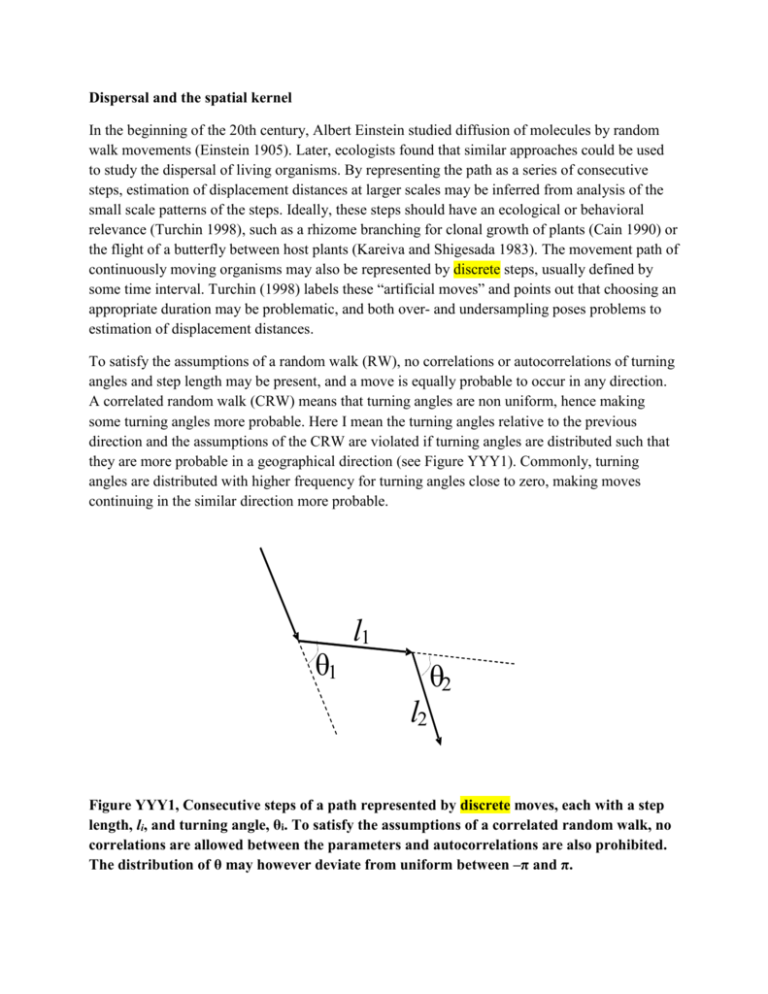
Dispersal and the spatial kernel In the beginning of the 20th century, Albert Einstein studied diffusion of molecules by random walk movements (Einstein 1905). Later, ecologists found that similar approaches could be used to study the dispersal of living organisms. By representing the path as a series of consecutive steps, estimation of displacement distances at larger scales may be inferred from analysis of the small scale patterns of the steps. Ideally, these steps should have an ecological or behavioral relevance (Turchin 1998), such as a rhizome branching for clonal growth of plants (Cain 1990) or the flight of a butterfly between host plants (Kareiva and Shigesada 1983). The movement path of continuously moving organisms may also be represented by discrete steps, usually defined by some time interval. Turchin (1998) labels these “artificial moves” and points out that choosing an appropriate duration may be problematic, and both over- and undersampling poses problems to estimation of displacement distances. To satisfy the assumptions of a random walk (RW), no correlations or autocorrelations of turning angles and step length may be present, and a move is equally probable to occur in any direction. A correlated random walk (CRW) means that turning angles are non uniform, hence making some turning angles more probable. Here I mean the turning angles relative to the previous direction and the assumptions of the CRW are violated if turning angles are distributed such that they are more probable in a geographical direction (see Figure YYY1). Commonly, turning angles are distributed with higher frequency for turning angles close to zero, making moves continuing in the similar direction more probable. θ1 l1 θ2 l2 Figure YYY1, Consecutive steps of a path represented by discrete moves, each with a step length, li, and turning angle, θi. To satisfy the assumptions of a correlated random walk, no correlations are allowed between the parameters and autocorrelations are also prohibited. The distribution of θ may however deviate from uniform between –π and π. If the path may be described by a CRW, the expected net squared displacement of the organism after 𝑛 steps, E(𝑅𝑛2 ), is approximated as given in Kareiva and Shigesada (1983) as E(𝑅𝑛2 ) ≈ 𝑛 (E(𝑙 2 ) + 2E(𝑙)2 𝜓 ) 1−𝜓 (1) where E(𝑙) is the mean move length, E(𝑙 2 ) is the mean squared move length and 𝜓 is the average cosine of the turning angle. The approximation holds for 𝑛 ≫ 1 and symmetric distribution of turning angle, meaning that left turns and right turns are equally probable. It is noteworthy that the expected net squared displacement increases linearly with 𝑛. For both RW and CRW, the spatial probability density of an organism converges to a Gaussian distribution as 𝑛 → ∞ (Okubo 1980). The probability distribution of an organism’s spatial location relative to its start point (assuming movement on a two dimensional surface) is then 𝑃(𝑥, 𝑦; 𝜎 2 ) = 1 2 2 2 𝑒 −(𝑥 +𝑦 )/(2𝜎 ) 2 2𝜋𝜎 (2) where 𝑥, 𝑦 are the spatial coordinates. Following e.g. Cain (1991), 𝜎 2 = 2𝐷𝑛, where 𝐷 is the diffusion constant which may be given from E(𝑅𝑛2 ) via 𝐷 = E(𝑅𝑛2 )⁄(4𝑛). Figure YYY2. Kurtosis, 𝜿, vs. movement step using the results from resampling method 4 𝟐 in paper XXX7. Here, 𝜿 was calculated as 𝜿 = 𝐄(𝑹𝟒𝒏 )/ (𝐄(𝑹𝟐𝒏 )) , where 𝐄(𝑹𝟒𝒏 ) is the mean fourth powered displacement and 𝐄(𝑹𝟐𝒏 ) is the mean squared displacement. The kurtosis tends to 𝜿 = 𝟐, which is the kurtosis of a two dimensional Gaussian distribution following the definition by raw moments in paper XXX6 In paper XXX7 we analyzed the movement pattern of a springtail and how this changed in response to food and conspecifics. We used net squared displacement as a measurement of the animals tendency to stay in the area. The shape of the spatial kernel was however not within the scope of the paper and therefore not included. FigureYYY2 show estimations of kurtosis of resampling method 4 and how it changes with time (one step had a fixed duration of one second). As 𝑛 becomes large, kurtosis tends to 𝜅 = 2, which is the kurtosis expected of a two dimensional Gaussian distribution (Clark et al. 1998, paper V). While no formal proof is provided, this indicate that inclusion of higher order correlations in movement parameters in the resampling method changed the prediction on displacement scale (measured as E(𝑅𝑛2 )) but not the shape (measured as 𝜅). Living organisms are however not molecules and therefore they may not necessarily be modeled accurately by a random walk assumptions. The distribution of observed dispersal distances are commonly leptokurtic, and this is found for a wide range of taxa within both plants (Johnson and Webb 1989, Clark 1998, Clark et al. 1999, Nathan et al. 2003, Yamamura 2004, Skarpaas and Shea 2007) and animals (Inoue 1978, Fraser et al. 2001, Schweiger et al. 2004, Walters et al. 2006, Coombs and Rodríguez 2007). Leptokurtic means that the distribution has a higher kurtosis than a Gaussian distribution. Making this ecologically relevant, Clark et al. (2001) state that “…the leptokurtosis in the distribution also produces greater distinction between short- and longrange dispersal events”. The opposite, platykurtic distributions, are rarely found, but Holmes (1993) showed that such distributions may be expected by the mere fact that animals have a finite speed when moving. Various explanations have been proposed for explanation of leptokurtic distributions. Most commonly it is considered the result of differences in the dispersal process (Hawkes et al. 2009) which may be due to behavioral differences (Dobzhansky and Wright 1943, Shigesada et al. 1995, Fraser and Bernatchez 2001, Fraser et al. 2001) or a result of external factors influencing the dispersal (Johnson and Webb 1989, Shigesada et al. 1995, Clark 1998, Clark et al. 2001). Other reasons include loss of individuals during dispersal (Schneider 1999) and temporal variation in the diffusion constant (Yamamura et al. 2007). Kurtosis is generally considered a measure of “shape”. More specifically, it is defined as the fourth moment divided by the square of the second moment, the latter being the variance in the one-dimensional. Symmetrical kernels (i.e. assuming equal probability of dispersal in every direction) are centered at the origin of the dispersal event for both one- and two-dimensional cases. Hence it makes sense to evaluate this property as “raw moment”, meaning that the moments are evaluated around the center rather than the mean. This distinguishing makes no differences in the one-dimensional case, but it aids the interpretation for the two-dimensional case. Clark et al. (1999) points out that there is no convention for calculating kurtosis for twodimensional kernels, but states that if the kernel is symmetrical, bivariate measures of kurtosis are undesirably complex. They further argue that the moments should be defined by the distance from zero (rather than Cartesian x-y-coordinates), which is also consistent with the dispersal distance data often collected in field studies, and kurtosis calculated by such moments capture the desired measure of shape. It is noteworthy that kurtosis is dimensionless. Any unit 𝑢 cancels out in the division of the fourth moment, with unit 𝑢4 , by the square of the second moment, with unit 𝑢2 . Hence, the shape is not confused with the scale. In my opinion this makes the analysis of the spatial kernel by its moments superior to more subjective studies of long distance dispersal (LDD), where LDD events are defined by some fixed distance or some (arbitrary) percentages of the observed dispersal distances (Nathan 2006). Many studies have focused on the kernel characteristics, in particular in relation to invasion speed (e.g. Mollison 1977, van den Bosch et al. 1990, Shigesada et al. 1995, Kot et al. 1996). Kot (1996) summarizes that there are three types of spatial kernels that needs to be considered for studies of biological invasion: 1) Kernels with exponentially bounded tails. Invasions with such dispersal show a constant invasion rate such that the range of the population expands linearly (or, equivalently, the square root of the area increases linearly). The kernels used in papers I, III, IV, V, VI and 1 VII falls under this category for parameter 𝑏 ≥ 1 (i.e. 𝜅 ≤ 3 3). 2) Kernels without exponentially bounded tails but with finite moments. Such kernels give rise to accelerating invasions. The kernels used in papers I, III, IV, V, VI and VII falls 1 under this category for parameter 𝑏 < 1 (i.e. 𝜅 < 3 3) 3) Kernels without finite moments. These are extremely fat tailed kernels, and analytic approximations of invasion speed is only possible for special cases. For the latter, it may be unrealistic that the dispersal distances are characterized by non finite moments, but Levy flights, which fall under this category, have shown good fit with observed data (Viswanathan et al. 1996, Schick et al. 2008). However, Skarpaas and Shea (2007) points out that “all realized dispersal distributions consist of a finite number of dispersal events and therefore have exponentially bounded tails”. Also, accelerating invasions may be the result of other factors than the lack of exponentially bounded dispersal distances (i.e. kernel types 2 and 3 given by Kot et al. 1996). For example, recent studies of cane toad invasion in Australia conclude that the accelerating invasion speed is a result of heterogenic environments and different evolutionary pressures at the front of the invasion (Urban et al. 2008). Kernel kurtosis and disease spread Spatial kernels have been used excessively in epidemiological studies as well (Mollison 1977, van den Bosch et al. 1990, Mollison et al. 1994, Boender et al. 2007), which comes as no surprise given the previously mentioned similarities between the fields. Mollison et al. (1994) states that “Key questions for spatial disease dynamics concern long distance contacts…” and they conclude that analysis of transport pattern is a promising approach. It is in this light that papers I and III estimates the spatial kernel of between herds contact probabilities via animal movements. In ecological studies, a Gaussian shape may (theoretically) be assumed, but mechanistically based assumptions regarding kurtosis of the kernels used for human induced contacts are difficult to obtain. There is (obviously) no underlying random walk process, and therefore no reason to assume a Gaussian distribution. Neither are there any mechanistic reasons for assuming a (discrete or continuous) mixture of Gaussian distributions, as is often done in ecology (Hawkes 2009) when explaining leptokurtosis. In paper III we however state that kurtosis can be interpreted as a measure of heterogeneity of the spatial process, even though we do not assume that there is a mixture of Gaussian processes. Intuitively this makes sense, and here follows further analysis of the subject. Suppose a mixture of processes, where process 𝑖 is described by a spatial kernel 𝑓𝑖 (𝑥) with kurtosis 𝜅̂ . Kurtosis is defined as the fourth moment divided by the square of the second moment, i.e. the kernel variance. Hence, for each process ∞ ∫0 𝑥 4 𝑓𝑖 (𝑥)𝑑𝑥 𝜇4𝑖 = = 𝜅̂ 𝑉𝑖2 (∫∞ 𝑥 2 𝑓 (𝑥)𝑑𝑥)2 𝑖 0 (3) Hence, 𝜇4𝑖 = 𝜅̂ 𝑉𝑖2. Further assume that the resulting mixture distribution 𝐹 consists of a fraction 𝑤𝑖 (where ∑𝑖 𝑤𝑖 = 1) of every mixture component 𝑖. Then the fourth moment of 𝐹, 𝜇4𝐹 , is ∞ 𝜇4𝐹 = ∫ 𝑥 4 ∑(𝑤𝑖 𝑓𝑖 (𝑥)) 𝑑𝑥 = ∑ 𝑤𝑖 𝜇4𝑖 0 𝑖 (4) 𝑖 and the variance, 𝑉̅ , is given by ∞ 𝑉̅ = ∫ 𝑥 2 ∑(𝑤𝑖 𝑓𝑖 (𝑥)) 𝑑𝑥 = ∑ 𝑤𝑖 𝑉𝑖 . 0 𝑖 (5) 𝑖 The kurtosis of 𝐹 is then given as ∑𝑖 𝑤𝑖 𝜇4𝑖 ∑𝑖 𝑤𝑖 𝜅̂ 𝑉𝑖2 ∑𝑖 𝑤𝑖 𝑉𝑖2 𝜇4𝐹 𝜅𝐹 = 2 = = = 𝜅̂ (∑𝑖 𝑤𝑖 𝑉𝑖 )2 (∑𝑖 𝑤𝑖 𝑉𝑖 )2 (∑𝑖 𝑤𝑖 𝑉𝑖 )2 𝑉̅ (6) Hence, we may conclude that 𝜅𝐹 > 𝜅̂ if ∑𝑖 𝑤𝑖 𝑉𝑖2 ⁄(∑𝑖 𝑤𝑖 𝑉𝑖 )2>1 (both 𝜅𝐹 and 𝜅̂ are positive). From equation XXX5 we know that 𝑉̅ is real and positive (both 𝑤𝑖 and 𝑉𝑖 are real and positive for all 𝑖) and ∑ 𝑤𝑖 (𝑉𝑖 − 𝑉̅ )2 ≥ 0 (7) 𝑖 Expanding the square we obtain ∑ 𝑤𝑖 (𝑉𝑖2 − 2𝑉𝑖 𝑉̅ + 𝑉̅ 2 ) ≥ 0 (8) 𝑖 and if this is rewritten as three separate summations, then ∑ 𝑤𝑖 𝑉𝑖2 − ∑ 2𝑤𝑖 (𝑉𝑖 𝑉̅ ) + ∑ 𝑤𝑖 𝑉̅ 2 ≥ 0. 𝑖 𝑖 (9) 𝑖 where ∑𝑖 2𝑤𝑖 (𝑉𝑖 𝑉̅ ) = 2𝑉̅ ∑𝑖 𝑤𝑖 𝑉𝑖 = 2𝑉̅ 2 and ∑𝑖 𝑤𝑖 𝑉̅ 2 = 𝑉̅ 2 ∑𝑖 𝑤𝑖 = 𝑉̅ 2 (since ∑𝑖 𝑤𝑖 = 1). Equation XXX can then be rewritten as ∑ 𝑤𝑖 𝑉𝑖2 − 2𝑉̅ 2 + 𝑉̅ 2 = ∑ 𝑤𝑖 𝑉𝑖2 − 𝑉̅ 2 ≥ 0. 𝑖 (10) 𝑖 By the definition of 𝑉̅ , this is equal to 2 ∑ 𝑤𝑖 𝑉𝑖2 𝑖 − (∑ 𝑤𝑖 𝑉𝑖 ) ≥ 0 ↔ 𝑖 2 ∑ 𝑤𝑖 𝑉𝑖2 𝑖 ≥ (∑ 𝑤𝑖 𝑉𝑖 ) . (11) 𝑖 Hence, we may conclude that any mixture of distributions with the same arbitrary kurtosis 𝜅̂ will have a higher kurtosis unless 𝑤𝑖 = 1 for exactly one component (i.e. there is only one component) or 𝑉𝑖 = 𝑉̅ for all 𝑖 (i.e. all mixture components are identical).

